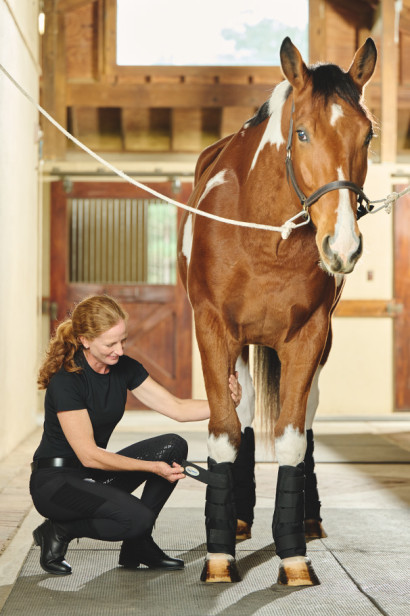Equine Therapy: Just How It Helps Build Confidence and Emotional Stamina
Equine Therapy: Just How It Helps Build Confidence and Emotional Stamina
Blog Article
Evaluating the Performance of Laser Therapy in Horse Treatment for Injury Rehab
The examination of laser therapy's efficiency in equine injury recovery rests on several variables, including healing time, pain reduction, and tissue regeneration. Professional studies recommend remarkable enhancements in conditions like tendonitis and osteoarthritis, attributed to enhanced cellular function and elevated ATP manufacturing. Vets regularly observe premium end results with laser treatment compared to traditional techniques, placing it as a crucial aspect in equine care. Nonetheless, the necessity for continual surveillance and tailored therapy strategies can not be overstated. What specific medical evidence supports these insurance claims, and exactly how do vets apply these methods in technique?
Recognizing Laser Treatment
Laser therapy has come to be a crucial device in veterinary medicine, particularly in the therapy of equine problems. Understood for its non-invasive nature and efficacy, laser treatment entails the application of certain wavelengths of light to promote tissue repair and lower swelling. This restorative modality is progressively favored for its ability to increase the recovery process in steeds dealing with a range of bone and joint injuries and persistent conditions.
The key mechanism behind laser therapy is its capability to boost cellular functions. Furthermore, laser treatment promotes vasodilation, enhancing blood circulation and oxygen distribution to damaged tissues, therefore quickening recovery.
In equine medicine, laser treatment is specifically advantageous for problems such as tendonitis, osteo arthritis, and wound healing. The method is admired for its pain-relieving residential properties, permitting steeds to regain movement and feature extra swiftly. Vets additionally appreciate its very little side impacts contrasted to various other therapy methods, making it a reliable and safe option for equine care.

Exactly How Laser Therapy Works

Upon absorption, these photons trigger a collection of biochemical changes, enhancing mitochondrial feature and bring about boosted adenosine triphosphate (ATP) production. This rise in ATP increases cellular metabolism, advertising cells repair work and regeneration. In addition, laser treatment regulates inflammatory reactions by impacting cytokine degrees and lowering oxidative anxiety, thereby alleviating discomfort and swelling.
Another considerable aspect of laser treatment is its function in enhancing microcirculation. The treatment promotes vasodilation, enhancing blood flow and oxygen shipment to damaged cells (Equine Therapy). This facilitates the elimination of cellular debris and supports the proliferation of fibroblasts and collagen synthesis, critical for injury healing
Professional Evidence
The effectiveness you can look here of laser treatment in equine therapy has actually been substantiated through various medical research studies, showcasing its restorative prospective throughout an array of problems. A research performed by Turner et al. (2012) showed that steeds treated with low-level laser treatment (LLLT) for ligament injuries showed increased recovery compared to those getting traditional treatments.
Likewise, research by Johnson and coworkers (2015) focused on equine muscular tissue injuries, exposing that laser therapy dramatically sped up muscle fiber regrowth and reduced muscular tissue tightness. Professional evaluations have revealed that laser treatment can minimize chronic conditions such as osteo arthritis.
Veterinarian Insights

Vets likewise appreciate the flexibility of laser therapy. She aims out that laser treatment can be customized to the particular needs of each horse, ensuring optimum results.
Furthermore, veterinarians value the capacity to incorporate laser therapy with other therapy techniques. This multimodal method can enhance total therapy effectiveness, providing a comprehensive remedy for equine recovery. Such endorsements from seasoned specialists highlight the growing acceptance and application of laser treatment in equine medication.
Practical Considerations
A vital element of executing laser treatment in equine treatment involves comprehending the useful factors to consider that Your Domain Name guarantee its effectiveness and safety and security. Most importantly, it is crucial to pick the appropriate laser device, as different types vary in wavelength, power, and infiltration deepness. Equine Therapy. Veterinarians need to be skilled in these specifications to customize therapy procedures successfully to every injury type
Additionally, the regularity and duration of laser therapy sessions require careful planning to make the most of therapeutic benefits while decreasing any type of potential damaging effects. Constant surveillance of the horse's action to therapy can direct needed changes in the therapy program. Developing a secure and regulated environment during therapies is additionally vital to stop accidental exposure to laser discharges, which might damage both the steed and the handler.
Training and accreditation of workers carrying out laser treatment are vital to make sure correct technique and to copyright safety requirements. Furthermore, preserving precise documents of each session, consisting of laser setups and observed results, is crucial for reviewing the total performance go right here of the therapy and for making data-driven decisions.
Final Thought
Laser treatment has actually emerged as a reliable technique in equine injury rehabilitation, offering considerable benefits in recuperation time, pain alleviation, and cells healing. For ideal results, continuous monitoring and individualized treatment methods stay vital in leveraging the full possibility of laser therapy in equine treatment.
Report this page